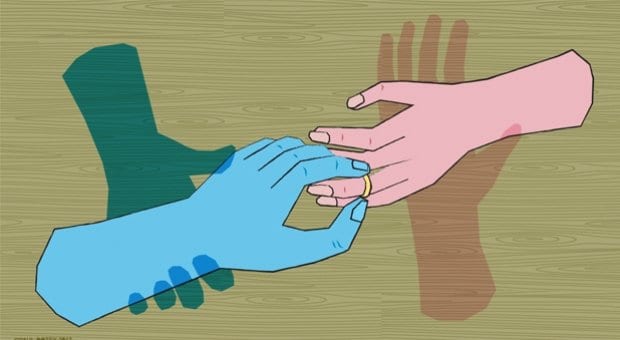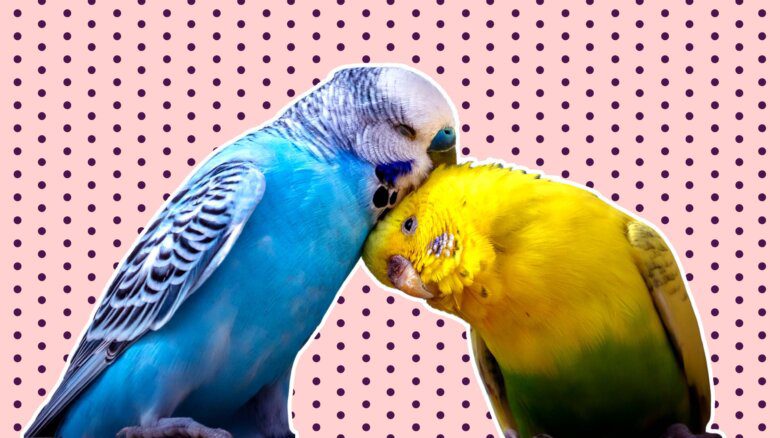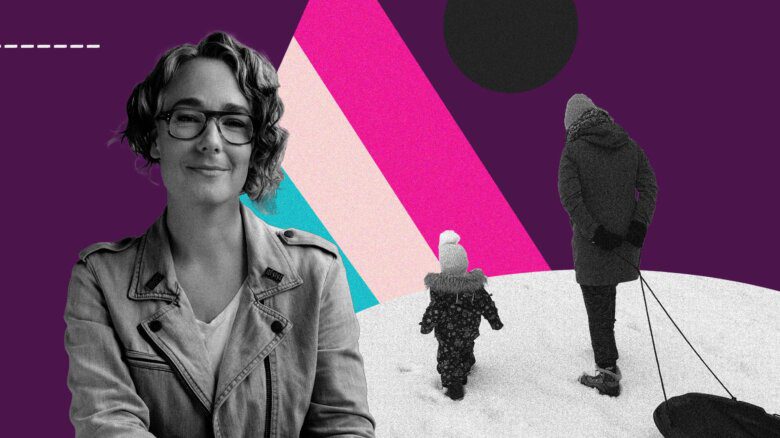“I knew from a fairly early age that I was attracted to both men and women.”
Playwright Martin Hunter leans forward in his seat, cradling a cup of coffee between his hands. He looks out the window at the traffic worming its way along Charles Street.
“But it was different back then. I had only a couple of slight sexual encounters with guys, and I thought it was sinful and that I shouldn’t be doing this. I wanted to have what was considered a normal life, and so I took girls out … and eventually I married one.
“And we’re now coming up to our 55th wedding anniversary, and we’ve had a pretty good life together.”
Hunter, a recent recipient of the Order of Canada, is currently promoting Still Hunting, a companion novel to his 2008 memoir Young Hunting. The book explores Hunter’s life during the early 1960s in Toronto, a time when he was newly married, transitioning into a job in the city, and adjusting to what he refers to as a fairly “bourgeois lifestyle.” This period would also see him undergo a personal transformation.
“The first 10 years of my married life, I was completely faithful to my wife. But I started to fool around [with men]. In the ’40s and the ’50s, there was no gay society the way there is today, but it gradually opened up. People started picking people up in bars, in the streets, at bathhouses, whatever. And I kind of got into that.”
Hunter’s story is a familiar one to gays and lesbians of the pre-Stonewall generation. At a time when homosexuality was classified as a mental illness and considered illegal in the eyes of the law, many people chose to live a life in the closet rather than risk persecution. But with the more permissive attitudes of the 1960s and early ’70s beginning to take hold, cracks had become apparent in the social fabric, and many gay people were starting to open up about their identities.
“I realized I was not alone. That there were other guys who were married … who also had boyfriends. Some of them, like Ian Scott [the former attorney general of Ontario], lived with a male partner but publicly denied it or brushed it aside. There were other people like Bill Glasgow or Laurier LaPierre who split with their wives and became openly homosexual.”
Hunter chose a slightly different path. Although he was discreet about his sexual preferences in his professional circles, he chose to be open with his friends and family and maintain his marriage while continuing to be sexually active with men. And his wife and children accepted it.
“I think my wife may have said to them, ‘Well, I don’t know, your father may find somebody he’d rather be with and take off.’ But that didn’t happen. And so I had affairs with people, but it was never a situation where I wanted to leave my wife and children and go off with somebody.”
Mixed-orientation marriages are still quite common. Although Canadian statistics on the subject are difficult to obtain, recent estimates range from under a million to up to three million in the United States alone. And much as they were in the past, these relationships are often the product of a complex interplay of factors, including repression and societal intolerance, as well as more consensual arrangements that reflect changing societal attitudes toward non-traditional families.
“With couples who remain married after both have come to accept they are mixed orientation … it is [often] born of a deep friendship and a desire to keep the family intact,” says Ellie Dwyer Rigby, a clinical psychologist working out of Connecticut. “For others, it is based on financial and/or religious/cultural considerations. And for others, [it’s] merely a desire to continue to live life as a nuclear family but also with an acceptance and understanding that each can pursue relationships outside of the marriage.
“As for how these end up, we don’t have any data that I am aware of. The couple needs to be on the same page for these marriages to last and thrive, [and] that takes an enormous amount of understanding and acceptance.”
Aadil, a bisexual man who spoke with Xtra on condition of anonymity, is keenly aware of the ways in which cultural and religious factors have influenced his decision to remain in a mixed-orientation marriage.
As a practising Muslim and a member of the South Asian community in Toronto, Aadil has been attracted to men since childhood but knew that pursuing homosexual relationships was simply not an option in his world. He has been married to a woman for more than 25 years, and although he insists that he is still very much in love with his wife, he continues to have an active sex life with men through bathhouse hookups and online arrangements. At one point, he even conducted a three-year relationship with a man on the side.
“Basically, every summer I would send [my family] back home, and that is my time to be alone and enjoy myself and go clubbing every weekend. I do everything. I met a guy, and we really took off in a relationship, but I was really upfront with him that I was married and I had to keep the marriage intact.
“We went through three years like that. I had brought him home to my wife, too, and introduced him as my friend. We would go for coffees Friday nights with my whole family, and then I would basically drop them home and the two of us would go off together. He knew my priorities, and he knew I had a child, and I didn’t want my family to suffer. But after three years he said he wanted [the relationship] to be full-time and permanent, and I told him that’s not going to happen. So I ended it.”
Still, even in bridging the gap between the two very different sides of his life, Aadil insists on keeping his homosexuality a secret.
“It’s a very hard time. And when I’m not with my family, then I’m [with men]. But when I’m with my family, I have to be more discreet. I’ve had incidents where I would look at the guys and my wife would say, ‘Do you like guys, too?’ She has her suspicions. But I can’t come out — culturally, it would be disastrous.”
But just how disastrous? Aadil recounts a story of another member of his community who fell on hard times after coming out of the closet.
“I knew one person — he used to work as a bank manager … in a good position. He had a wife and, I believe, three daughters. He used to do the same thing, lead a double life, and he said to his wife, ‘I prefer having sex with guys.’ And that was it. Total disaster. The marriage broke up, the family didn’t want to [maintain] a relationship with him, and the community didn’t help him. Within a month to two month’s time, he lost his job. The excuse that I heard was that they couldn’t keep up with his personal life, so they had to let him go. I still see him on Yonge Street or when you go to Gerrard, and he’s living on the streets.
“And my wife knows about [that situation], and she gets upset as to why the wife didn’t put up with that. So it’s harder for me to know what her reaction would be. I know that she has the same mind as me — we have a kid. And for the sake of the child, we have to put up with it.”
Whether deciding to stay together for children or for other reasons, getting to a point of acceptance is often difficult. “Early in my career, I would see these couples in my office, and it would break my heart because they often … still loved each other and both wanted to stay together,” says Joseph Kort, an American clinical social worker specializing in mixed-orientation marriages. “But because of the awakened sexuality issues, it was not possible, and the couples could not seem to make it work without an open relationship — which most didn’t want.
“So I [try] to help these couples try and stay together or leave with the best of integrity and good will toward each other.”
Interestingly, the path to mixed-orientation marriages can be different for the men and women involved. Dwyer Rigby says research suggests that the vast majority of men — 97 percent in one study — knew of their same-sex attraction before they got married. “[But] in the latest research on this subject, completed by my research partner Christan Moran, close to 50 percent of women had no awareness of a same-sex attraction prior to marrying and thus had considered themselves to be wholly heterosexual.”
Recent studies on late-blooming lesbians have suggested that this discrepancy could be due to genetics, with women possessing more sexual fluidity than their male counterparts. But Kort is skeptical.
“Gay men and lesbians often don’t know they have a gay identity. They think it is just a sexual kink or a true brotherly or sisterly love. There is not permission in our world to explore anything but a heterosexual identity, so it fogs people to the point where they don’t even know they are gay.”
Dwyer Rigby agrees that societal pressures still do play a role. “Do the men and women who were aware of their same-sex attraction marry out of convention and societal or religious or family expectation? Perhaps for many. And perhaps we will see less of this in the future, at least in this country, as people come to understand and accept homosexuality.”
Aadil could imagine a world where he would be able to be open. “If there was the right person in my life and we had a lot of things in common, maybe [I would be able to come out]. Again, it would be different if I didn’t have a child. But I’m not sure what the future will hold.”
Hunter, meanwhile, sees this as much more of an individual issue. “The whole thing about sexuality is it’s completely variable and it’s individual, so you do what you do. And other people chose to do what worked for them at the time.”
He expects that some may not understand his decision to go public with his story at this time, but he doesn’t regret his decision. “People say to me, ‘Oh, now you’re coming out of the closet at 80.’ Well, actually, in my own mind I’ve been out of the closet for a very long time because I didn’t try to hide this. I went to bathhouses and strip clubs. And some of my friends knew about it, and some of them didn’t.
“And this has been going on for 50 years. Although I’m slowing down these days, I suppose.”

 Why you can trust Xtra
Why you can trust Xtra


